Lenovo Yoga 3 Pro Review: Refreshed With Faster Core M
by Brett Howse on March 13, 2015 8:00 AM ESTSystem Performance
For the new model, Lenovo has taken the step of moving from the 15 watt Haswell-U series processors to the 4.5 watt Broadwell-Y based Core M. Their first run of Yoga 3 Pros came with the Core M-5Y70, which has a base frequency of 1.1 GHz, and a boost of 2.6 GHz. Lenovo has refreshed the Yoga 3 Pro to include the 5Y71 processor, which increases the base clock to 1.2 GHz and boost to 2.9 GHz. It will be interesting to see the performance delta between the Yoga 3 Pro and the Yoga 2 Pro.
The Broadwell-Y processors have two cores and hyperthreading. With a thermal envelope of just 4.5 watts though, boost clocks with heavily multithreaded workloads will be reduced as compared to the U series processors. During a multi-threaded run of Cinebench R15, the Core M processor would hover between 1700 and 1800 MHz, but the Core i5-5200U would do the same workload at 2400 MHz and not deviate at all. On single-threaded workloads, the Core M has more headroom to allow the one core to clock higher, and on a single-threaded run of Cinebench R15 it would clock as high as 2600 MHz. However there was a lot of variance during the run, and the Core M-5Y71 would fall as low as 1200 Mhz, with the majority of the time spent between 2000 Mhz and 2200 Mhz. Broadwell-U on the other hand would stay exactly at 2400 Mhz again during the same workload, with very little change in frequency during the run. As compared to Broadwell-U with a 15 watt TPD, the Broadwell-Y limits clock speed quite a bit more. Let’s go through some benchmarks to see how much this affects the Yoga 3 Pro, and especially if the IPC improvements with Broadwell can make up for the lower TDP.
For our benchmarks, I have selected a sample of similar devices in which to compare against. I have also included the Dell XPS 15, which has a quad-core CPU, GT750 GPU, and 91 Wh battery to bracket these scores on the high end. To compare against the low end, I have included the HP Stream 11, which has the Atom N2840 processor. It is interesting to note that the Atom (rebranded as Celeron) has a slightly higher TDP (7.5 watts vs 4.5 watts of the Core M) and it will be a good comparison to see how much more performance Core has than Atom. To compare the Yoga 3 Pro against any other devices, please check out our Notebook Bench.

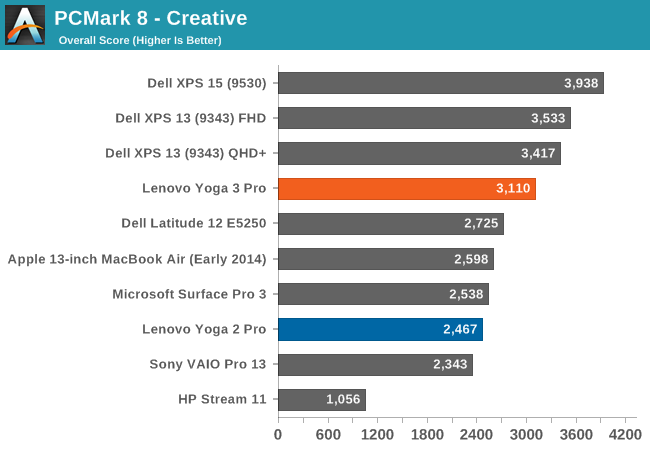
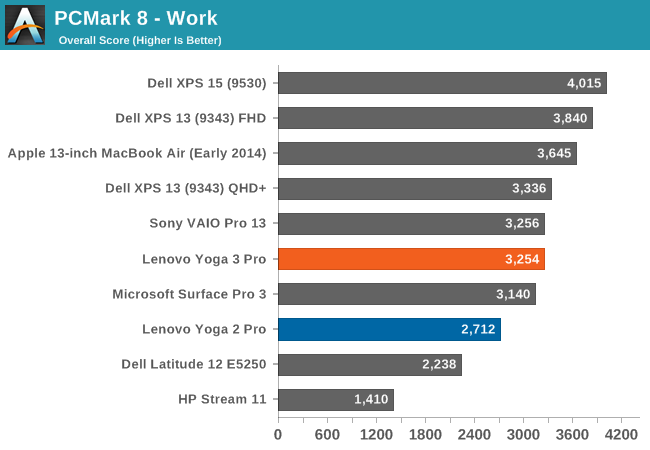
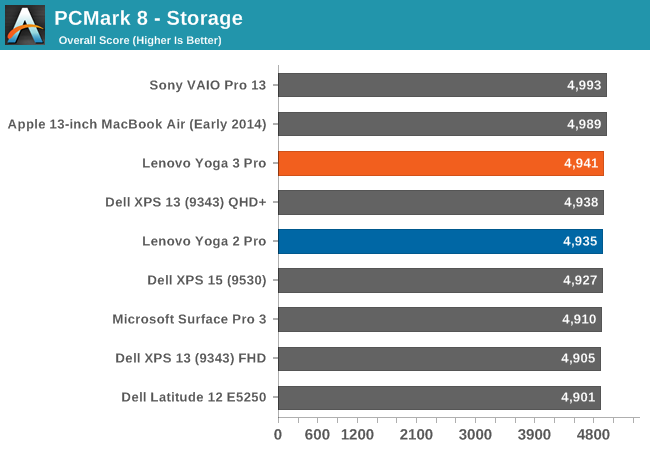
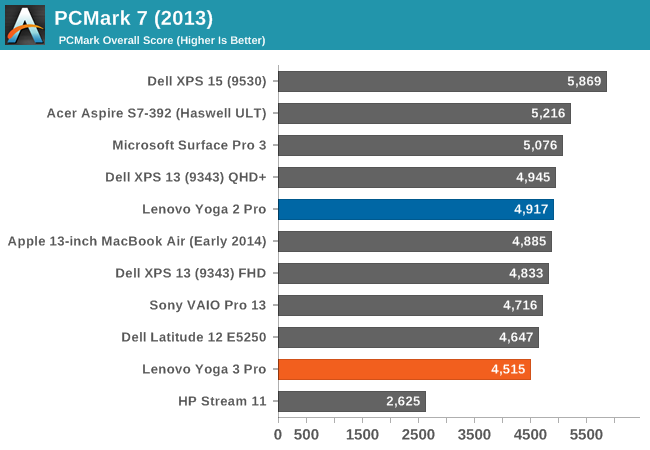
PCMark 8 has four workloads which are Home, Creative, Work, and Storage. Each has a different set of workloads which Futuremark believes represent a good sampling of tasks for each category. Here the Yoga 3 Pro does very well, with scores that are more often than not well above the Yoga 2 Pro’s Core i5-4200U. The Broadwell Core i5s in the XPS 13 still pull a good lead here. The 7.5 watt Bay Trail-M in the HP Stream is sorely outclassed by the 4.5 watt Core M.



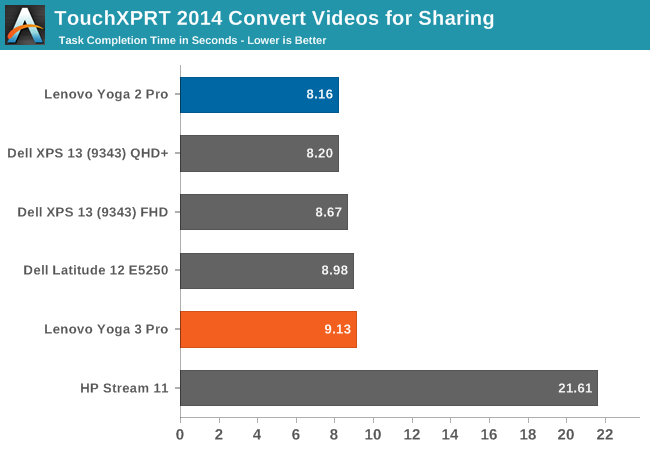
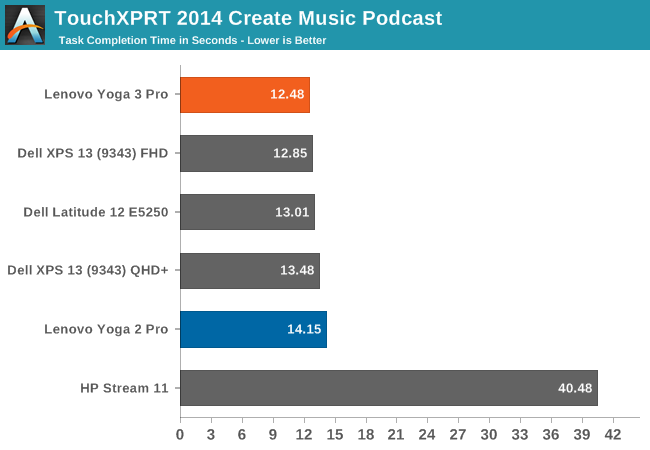

Our next benchmark is TouchXPRT 2014, which is a Windows Store app. It performs several common tasks for a typical home user, and converts the time taken for each task into an overall score. Once again, the 4.5 watt Core M compares very favorably to the 15 watt Yoga 2 Pro processor. In almost all of the tests, Core M is ahead of the Haswell Core i5-4200U of the Yoga 2 Pro. In order to achieve these scores, the GPU driver was updated to the latest version on the Intel site which fixes a problem with the Video Conversion score. We had the same issue with the XPS 13, so if you are the owner of a Broadwell laptop, you may want to update your drivers. The Atom core once again is decimated by Core M.
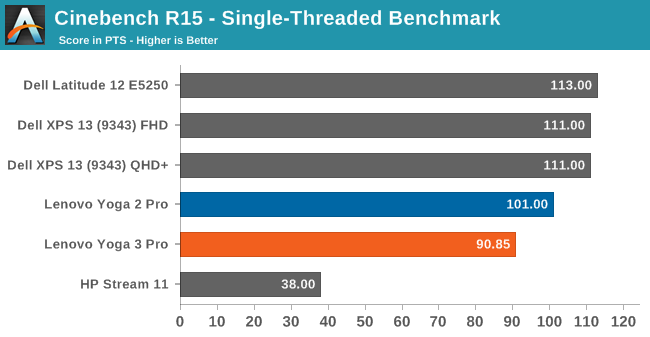

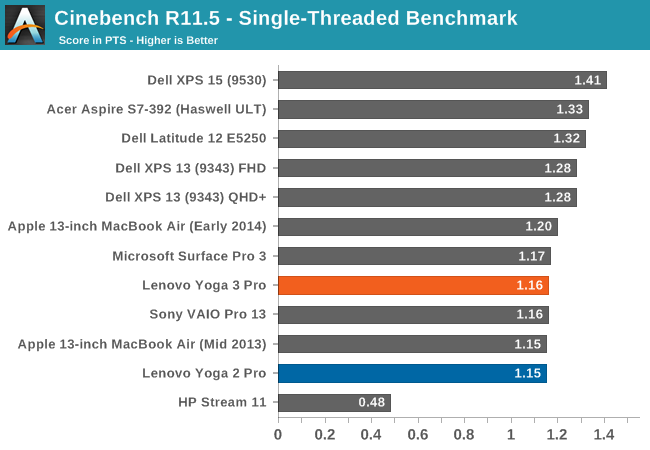
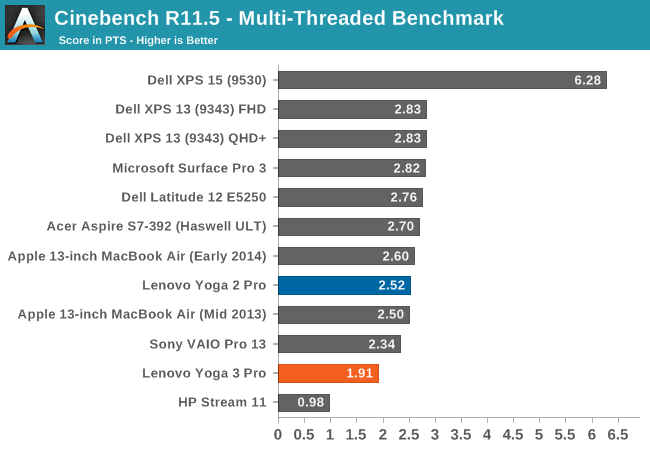


Cinebench is a good long benchmark which shows us how the CPU will perform when maxed out for the duration of the benchmark. Here we can see where Core M starts to falter. On long sustained workloads, it has to cut the CPU frequency to keep within its thermal envelope, whereas the Broadwell-U and Haswell-U CPUs can keep the clocks a lot higher. While running the multithreaded R15, the Core M would hover around 1800-1900 MHz with all cores in use, and the Broadwell-U would lock in at 2400 MHz and stay there for the duration. x264 is similar, and is a very long benchmark. The higher power envelope of the U series processors allow for more work to be done. You can see the quad-core Dell XPS 15 really pulls ahead on these benchmarks, and the HP Stream continues to fall well behind.
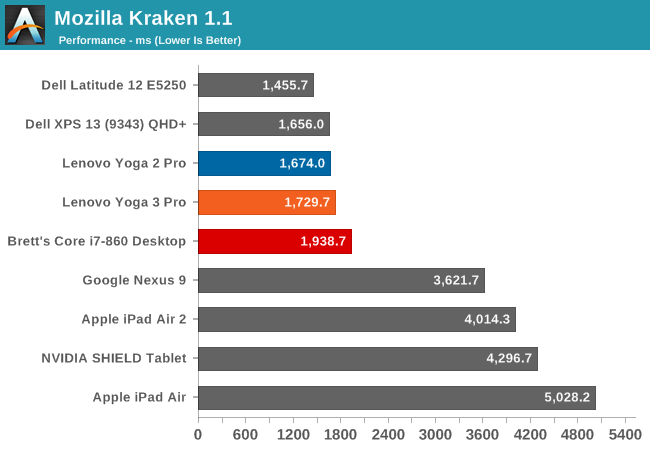

Once again, in web use, the Core M processor is very similar to the outgoing Haswell U based Yoga 2 Pro. Just to put the numbers in a bit more context, I also ran the benchmarks on my Core i7-860 based Desktop (running Chrome, as were the Yogas) and it is pretty clear just how far we have come. The i7-860 is a four core, eight thread 45 nm processor with a 2.8 GHz base clock and 3.46 GHz boost, all in a 95 watt TDP. It was launched in late 2009. Five years later, we have higher performance in a 4.5 watt TDP for many tasks. It really is staggering.
There seems to be a general concensus that Core M equates slow, but clearly this is not the case. For some sustained workloads, yes, the 4.5 watt TDP limits how much performance you are going to get from the CPU, but for many tasks, especially short burst loads, the performance of the 5Y71 is very competitive, often outperforming the Haswell Core i5-4200U from last year’s Yoga 2 Pro. This says a tremendous amount about the Intel 14 nm process, because the IPC improvements of Broadwell vs Haswell are fairly limited. Clearly the CPU has quite a bit of headroom on the 14 nm process to keep the clock speeds up.










113 Comments
View All Comments
coolhardware - Friday, March 13, 2015 - link
I'm hoping Lenovo follows in Dell's footsteps and gets rid of the bezel around the screen along with big wasted area around the keyboard.Pretty sweet to get the same display size and pixel density:
13.3″ 75.59 square inche display (11.6″x6.5″) 3200×1800 16:9 Ratio 276.05 PPI
***all in a much smaller form factor!***
*Source for display specs: http://pixensity.com/list/laptop/
fokka - Friday, March 13, 2015 - link
the thing is for the tablet mode it's nice to have some bezel to grip the whole thing, so going the minimal bezel route like the xps 13 wouldn't be the most comfortable thing on a device like a yoga 3 pro.that's the same reason we have the big wasted space around the keyboard: that's where you hold the device in tablet mode. i think they still should have given us at least a row of half-height function keys, but we see that a convertible is always a compromise.
fokka - Friday, March 13, 2015 - link
agreed. the hinge might look nice to some and as long as it works it's fine by me, but if they go ahead and bost about it consists of over 800 parts, that just screams "over engineered" to me.i also don't see how a simple hinge has to look like a watchband, or a piece of jewelry and again: using 800 parts, when you could reach the same goal with just two is simply too much in my book.
Cook-e-Monster - Friday, March 13, 2015 - link
Hugely disappointing to see the keyboard get compromised like this. one of the most useful things about Lenovo is that they make good keyboards with intelligent layouts. Nixing the F-row and hamstringing the PgUp/Down and Home/End keys is probably a deal breaker for me.I really hope that there's a review coming for the recent HP Spectre. I think it (and the XPS) has Lenovo beat this year
Sushisamurai - Friday, March 13, 2015 - link
I appreciate you linking the notebook bench link, but the Lenovo Yoga 3 Pro isn't listed on your bench results yet (nor in CPU bench). I was also hoping there would be more of an in-depth discussion about the Core-M CPU and probably a few more "real life" use case results and short comings of the CPU, as this is Anandtech's first product review with a Core-M.I like how you included Dell's XPS 15, but for those unfamiliar with that model, I think you should have at least mentioned what CPU it was other than being a quad-core CPU. Without bench results, it's also hard to compare what core-M's performance is compared to other broadwell/Haswell offerings as the charts are comparing tablets and some Haswell-U's. I think it'd be an interesting dive to see what users would be sacrificing in terms of performance to go to Core-M (form-factor) versus intel's bigger mobile processors. I suppose I could wait for the bench results and pore over the charts myself, and since anyone can do that, that's not why we read anandtech.
Brett Howse - Saturday, March 14, 2015 - link
Sorry the Yoga 3 Pro was in Bench but not enabled for public viewing until after I posted. I just enabled it now.I did mention in the article that the Dell is a quad-core part. I have some more ideas as well to make that more clear but it's a backend thing.
Look for more Core M discussion soon. We had issues getting samples at the start since it seemed like a really slow release but we have some now. I've got a couple more Core M devices in my queue to look at.
Sushisamurai - Sunday, March 15, 2015 - link
Sweet. I'm looking forward to more core-M reviews. I think a lot of our readers are interested in reading what you guys have to say about the new MB apple released.Also, I'm aware other products' performance is listed in bench but it would be nice to include products that match the one you're reviewing in terms of size, form factor, and price - I felt that the products you included in your charts were heavily skewed to tablet comparisons, where we could have used some more comparisons for products in similar price ranges.
Otherwise, good read, thank you for your hard work.
sandineyes - Friday, March 13, 2015 - link
I actually bought a Yoga 3 Pro (my first laptop in over 10 years) during the holiday season, and eventually returned it after a few weeks. My thoughts:-The build quality on this thing is pretty poor for such an expensive device. The panel on the back of the screen on mine flexed quite a bit, as if it didn't fit perfectly. Similarly, there is a piece of plastic below the display that looks like it is fit into a rectangular slot, and that wiggled around too, as if it was glued poorly or something. It also shows usage very poorly; no amount of hand washing prevented it from looking like a mess after using it. I had a chance to touch a MBP while I owned this, and that felt markedly better made.
-The screen is not very good. It wasn't really that much of a problem, and the article mentions it getting better in the refresh, but mine was pretty poor. It was also my introduction to HiDPI Windows and all the caveats that come with that. I am also used to my 16:10 desktop monitor, so I'm probably a bit biased. But seriously, we need more 16:10 laptop screens that aren't on Macs.
-It generally felt fast enough, but mine could not handle HD streaming on Amazon Instant Video (tried Chrome and latest IE). The video would start stuttering, making it un-watchable. Netflix didn't have this issue, and neither did a 1080p video stored locally when used with VLC. I don't know if the refresh has this issue, but it made Amazon Instant Video a last resort.
-The battery life is terrible. I am not really used to laptops, so for me the 5 hours of life I managed out of the thing felt very oppressive. And although this is a minor issue, the included charging cable is too short.
-The last laptop I owned had physical click buttons; my index finger worked the pad, and my thumb rested on the left click button. Based on the Yoga I cannot see how people have adapted to use these new-fangled track pads with no buttons. It is like we've actually regressed in technology over the last 10 years when it comes to this. Getting click and drag to work on these damn things is real challenge.
-Make sure you keep that Harmony software installed; otherwise the computer won't properly deactivate the keyboard and track pad when in stand mode.
-This computer makes me want more, better hybrids to exist. Because of the utility of stand mode, I do not think I can ever buy a normal laptop or a tablet. The light weight of this thing is also a plus, but I think that is more a benefit to tablet mode, which isn't that useful in comparison to the other modes.
fokka - Friday, March 13, 2015 - link
thanks for your quick review, it's interesting to hear some real life caveats, even if you didn't use the latest model.i also share some of the same complaints about at least some of the current ultrabooks. i recently got to test an asus zenbook (ux301la) and while it looked stunning with its white glass finish, it only stood on three of its rubber feet and kept wiggling, as you moved your hand to and from the palm rest. even the (buttonless!) glass touchpad made a slight squeaking sound, when you moused around on it.
it seems to me that many manufacturers have a problem converting those nice press renders and incredibly high specs into really usable products that don't show some serious flaws after a short amount of time.
many people say this machine (e.g. a zenbook), or that laptop (e.g. the new xps 13) offer incredible build quality, but still i have to see one laptop model to offer such a continuously high build quality as apple does with their whole macbook line. a shame, since i'm really not a fan of osx.
i'm also not the biggest fan of hi dpi screens, especially when the effect is made obsolete due to the use of a pentile matrix. it seems we're just wasting money, energy and gpu cycles, hell, even usability (->scaling), just to have one more spec to boast about. and all this on the machines that are conceptually the worst place to start the dpi-revolution: battery and performance limited mobile devices.
"The screen is not very good." ...if people sum up a screen with those (your) words, i think we can agree that this specific panel was a poor choice on a somewhat premium device like the yoga 3 pro.
and a new $$$$ laptop not managing 1080p playback on one of the biggest VoD services... i think i have seen enough of core m for one day, even if that specific problem turns out to be driver related.
kyuu - Saturday, March 14, 2015 - link
Considering that you can go to the HP website right now and get the Spectre x360 with 1080p touch, 8GB of RAM, a 256GB SSD, a Core-i5 5200U, a much larger battery and what looks like much better build quality all for under $1000, I'm afraid Lenovo needs to do more than this refresh to keep the Yoga line competitive. You can even upgrade to a QHD display for only another $100, if you prefer resolution to battery life. Hopefully you guys get in a Spectre x360 for review in the near future.And if you don't care about a 360-degree hinge and a touchscreen, then the Dell XPS 13 knocks it out of the park.